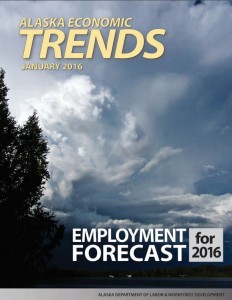
As oil prices have dropped to levels that were unthinkable just a year ago, many Alaskans are wondering whether the state is facing economic calamity.
The short answer is: not yet. Last year, the state added jobs, despite plunging oil prices. In fact, oil and gas employment reached a record high in 2015.
In its annual employment forecast, out this month, the Alaska Department of Labor predicts modest job losses in the year ahead. Those losses are expected to be concentrated in the oil and gas industry; in state government, where budget cuts are expected to cull the ranks of state workers; and in the construction industry, which relies on both oil and gas and government spending for projects.
If the forecast is right, it will be the first net job loss the state has seen since 2009. But the Department anticipates the decline will be less than one percent — and doesn’t expect major ripple effects.
We spoke with state labor economist Neal Fried, to ask how it’s possible that at $30 dollars a barrel, Alaska is still doing pretty well.
FRIED: When we look at oil industry employment for 2015, we started out the year quite strong. In other words, employment numbers at the first part of 2015 were the highest they’d ever been, and by the time we got to the end of last year, we started to lose ground compared to 2015. So we saw that trend happen.
And we saw that with state government as well. A little different. It started out slightly negative in 2015, and as the year went by, by the time the third quarter was over, we started seeing numbers that were a thousand or more lower than they were the previous year. So we’ve seen those two clear signals that come probably as a result of lower oil prices.
But again, if I just looked at total employment, total income, those big, big numbers, it would be hard to find.
WALDHOLZ: Hard to find any signal of $30 a barrel oil right now?
FRIED: That’s correct.
WALDHOLZ: And are you surprised that we’re not seeing a bigger impact yet?
FRIED: I am sort of surprised. We are in sort of uncharted waters. I forecast Anchorage, and last year I actually forecasted us to lose ground, employment-wise. And we didn’t, I was wrong. We actually ended up slightly positive in 2015. And as I said, we are forecasting again this year, statewide and for all the areas that we forecast for, we are forecasting some job loss, overall job loss, and that is tied to the price of oil.
Most of the job losses that we’re looking at, that we think are going to occur, are tied to state government and the oil industry, and things tied to that industry.
WALDHOLZ: Turning to the oil and gas industry itself, there have been a few announcements of high-profile layoffs – at ConocoPhillips, BP. But overall, how is the industry doing?
FRIED: Well, right now, if you look at the numbers right now, they still look relatively high from an historical perspective. But that could change.
The biggest numbers out there in the oil sector are not the producers, are not the BPs and the Conocos. It’s really the service companies that are the biggest players, the drillers, the service companies like Halliburton or Doyon Services. And so we’re waiting to see what happens there. And you’re less likely to get a public announcement from that side of the industry, although I think eventually we will hear about it. And we do get their numbers, so eventually that will be calculated in our monthly employment statistics.
WALDHOLZ: How is Alaska different than, say, North Dakota? Where you’ve seen companies go bankrupt, where you’ve seen big layoffs, where you’ve seen rigs come out of the ground. It seems like our oil industry just operates differently, we can’t bust as fast just because we aren’t built that way.
FRIED: I think part of it may be that. That’s going to be answered in the next year or two. We appear to be more project-based. When you undertake a project in Alaska, it’s usually a pretty big one. So if you’re in the middle of it, or a third of the way through, you’re not going to just probably quit. On the other hand, if you’re in a place where you can just punch lots of holes in the ground, drive a truck somewhere on a road and punch holes, you can end that activity, as well, much more quickly. So it’s much easier to shut things down in many of those places.
Neal Fried also serves on Alaska Public Media’s Board of Directors.
Rachel Waldholz covers energy and the environment for Alaska's Energy Desk, a collaboration between Alaska Public Media, KTOO in Juneau and KUCB in Unalaska. Before coming to Anchorage, she spent two years reporting for Raven Radio in Sitka. Rachel studied documentary production at the UC Berkeley Graduate School of Journalism, and her short film, A Confused War won several awards. Her work has appeared on Morning Edition, All Things Considered, and Marketplace, among other outlets.
rwaldholz (at) alaskapublic (dot) org | 907.550.8432 | About Rachel




